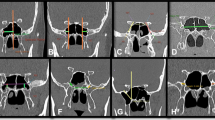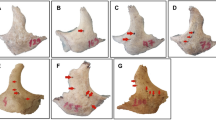Abstract
The presence and description of anatomical findings about the foramen of Vesalius (FV) is important in the surgical procedure on the trigeminal nerve and/or trigeminal ganglion. This is an evaluation area for percutaneous techniques. A morphological analysis of the FVs was made in a total of 344 sides of the basis cranii of adult skulls by computerized photogrammetry using standardized digital photographs. The FV was identified in 60 specimens (34.8 %). The FV was observed to be present bilaterally in 16 specimens (9.3 %). The incidence of unilateral FV was 25.5 % of the skulls, of which in 26 specimens (15.1 %) it occurred on the left side, and in 18 specimens (10.4 %) on the right side. The FV was observed to present a double opening in two specimens. The diameters of the FV were found to be 0.86 ± 0.21 (right) and 1.07 ± 0.37 mm (left). The incidence of openings with a diameter of FV 0.5 mm or more was found to be 45 %. The area of the FV was calculated as 1.09 ± 0.51, and 1.4 ± 0.83 mm2 on the right and the left, respectively. The mean distances of FV to the foramen ovale were measured as 2.30 ± 1.14 mm (right) and 2.46 ± 0.89 mm (left). The mean distances of FV to foramen spinosum were found to be 10.76 ± 1.26 mm (right) and 10.42 ± 1.29 mm (left). The findings suggest that the diameter of FV as <0.5 mm was safer to work with, while the opening types bigger than 0.5 mm opening types were highly risky for percutaneous techniques on the foramen ovale. In our study, a clear standardization has been achieved. The findings were the data obtained through computer-assisted three dimensional landmarks, appropriate for use in three dimensional planning.




Similar content being viewed by others
References
Alvernia JE, Sindou MP, Dang ND, Maley HJ, Mertens P (2010) Percutaneous approach to the foramen ovale: an anatomical study of the extracranial trajectory with the incorrect trajectories to be avoided. Acta Neurochir 152:1043–1053
Berge JK, Bergman RA (2001) Variations in size and in symmetry of foramina of the human skull. Clin Anat 14(6):406–413
Bergman RA (2011) Thoughts on human variations. Clin Anat 24(8):938–940
Boyd GI (1930) Emissary foramina of cranium in man and the anthropoids. J Anat 65:108–121
Chaisuksunt V, Kwathai L, Namonta K, Rungruang T, Apinhasmit W, Choompoopong S (2012) Occurrence of the foramen Vesalius and its morphometry relevant to clinical consideration. Sci World J 817454. doi:10.1100/2012/817454
Douglas TS (2004) Image processing for craniofacial landmark identification and measurement: a review of photogrammetry and cephalometry. Comp Med Imaging Graph 28:401–409
Ginsberg LE, Pruett SW, Chen MY, Elster AD (1994) Skull base foramina of the middle cranial fossa: reassessment of normal variation with high-resolution CT. Am J Neuroradiol 15(2):283–291
Gupta N, Ray B, Ghosh S (2005) Anatomic characteristics of foramen Vesalius. Kathmandu Univ Med J 3(2):155–158
Hinteregger M, Zschiegner F, Lirk P, Ladner E, Goeschl A, Gaber O, Moser P, Lorenz I, Kolbitsch C (2004) A new guidance device facilitates percutaneous puncture of the foramen ovale in human cadavers. Can J Anaesth 51(10):990–992
James TM, Presley R, Steel FL (1980) The foramen ovale and sphenoidal angle in man. Anat Embryol (Berl) 160:93–104
Kale A, Aksu F, Ozturk A, Gurses AI, Gayretli O, Zeybek FG, Bayraktar B, Ari Z, Onder N (2009) Foramen of Vesalius. Saudi Med J 30(1):56–59
Kanpolat Y, Savas A, Bekar A, Berk C (2001) Percutaneous controlled radiofrequency trigeminal rhizotomy for the treatment of idiopathic trigeminal neuralgia: 25 year experience with 1,600 patients. Neurosurgery 48(3):524–532
Kaplan M, Erol FS, Ozveren MF, Topsakal C, Sam B, Tekdemir I (2007) Review of complications due to foramen ovale puncture. J Clin Neurosci 14(6):563–568
Keskil S, Gozil R, Calguner E (2003) Common surgical pitfalls in the skull. Surg Neurol 59(3):228–231
Kim DI, Kim HS (1995) High resolution CT evaluation on the morphologic characteristics and variations of foramen ovale and adjacent foramina in the skull base. J Kor Radiol Soc 33(1):43–48
Kocaogullar Y, Avci E, Fossett D, Caputy A (2003) The extradural subtemporal keyhole approach to the sphenocavernous region: anatomic considerations. Minim Invas Neurosurg 46(2):100–105
Kodama K, Inoue K, Nagashima M, Matsumura G, Watanabe S, Kodama G (1997) Studies on the foramen Vesalius in the Japanese juvenile and adult skulls. Hokkaido Igaku Zasshi 72(6):667–674
Kuether TA, O’Neill OR, Nesbit GM, Barnwell SL (1996) Direct carotid cavernous fistula after trigeminal balloon microcompression gangliolysis: case report. Neurosurgery 39(4):853-855 (discussion 855–856)
Lanzieri CF, Duchesneau PM, Rosenbloom SA, Smith AS, Rosenbaum AE (1988) The significance of asymmetry of the foramen of Vesalius. Am J Neuroradiol 9(6):1201–1204
Liu M, Wu CY, Liu YG, Wang HW, Meng FG (2005) Three-dimensional computed tomography-guided radiofrequency trigeminal rhizotomy for treatment of idiopathic trigeminal neuralgia. Chin Med Sci J 20(3):206–209
Lunsford LD, Niranjan A, Kondziolka D (2007) Surgical management options for trigeminal neuralgia. J Kor Neurosurg Soc 41:359–366
Ramalho AJC, Sousa-Rodriguez CF, Rodas PMM, Lins CJP, De Lima RL, Almeida ETDL, Neto JABS (2007) A incidência e as relações morfométricas do forame emissário do esfenóide em crânios humanos. Int J Morphol 25(1):147
Reymond J, Charuta A, Wysocki J (2005) The morphology and morphometry of the foramina of the greater wing of the human sphenoid bone. Folia Morphol (Warsz) 64(3):188–193
Sekimoto K, Koizuka S, Saito S, Goto F (2005) Thermogangliolysis of Gasserian ganglion under computed tomography fluoroscopy. J Anesth 19(2):177–179
Shapiro R, Robinson F (1967) The foramina of the middle fossa: a phylogenetic, anatomic and pathologic study. Am J Roentgenol 101:779–794
Shinohara AL, de Souza Melo CG, Silveira EM, Lauris JR, Andreo JC, de Castro Rodrigues A (2010) Incidence, morphology and morphometry of the foramen of Vesalius: complementary study for a safer planning and execution of the trigeminal rhizotomy technique. Surg Radiol Anat 32(2):159–164
Sindou M, Keravel Y, Abdennebi B, Szapiro J (1987) Neurosurgical treatment of trigeminal neuralgia. Direct approach or percutaneous method? Neurochirurgie 33(2):89–111
Sweet WH, Poletti CE (1988) Complications of percutaneous rhizotomy and microvascular decompression operations for facial pain. In: Schmideck HH, Sweet WH (eds) Operative neurosurgical techniques: indication, methods, and results. Grune and Straton, Orlando, pp 1139–1144
Tatli M, Sindou M (2008) Anatomoradiological landmarks for accuracy of frequency thermorhizotomy in the treatment of trigeminal neuralgia. Neurosurgery 63 (1Suppl 1):ONS129-37
Williams PL, Bannister LH, Martin MM et al (1995) Gray’s anatomy, 38th edn. Churchill Livingstone, London, pp 425–736
Wysocki J, Reymond J, Skarzynski H, Wrobel B (2006) The size of selected human skull foramina in relation to skull capacity. Folia Morphol 65(4):301–308
Conflict of interest
No financial conflict of interest exists with any commercial entity whose products are described, reviewed, evaluated or compared in the manuscript. None of the authors has a financial interest in any of the product, devices or drugs mentioned in this article. This article has not been submitted or published elsewhere in part or in whole and that it is original work.
Author information
Authors and Affiliations
Corresponding author
Rights and permissions
About this article
Cite this article
Ozer, M.A., Govsa, F. Measurement accuracy of foramen of vesalius for safe percutaneous techniques using computer-assisted three-dimensional landmarks. Surg Radiol Anat 36, 147–154 (2014). https://doi.org/10.1007/s00276-013-1148-7
Received:
Accepted:
Published:
Issue Date:
DOI: https://doi.org/10.1007/s00276-013-1148-7




